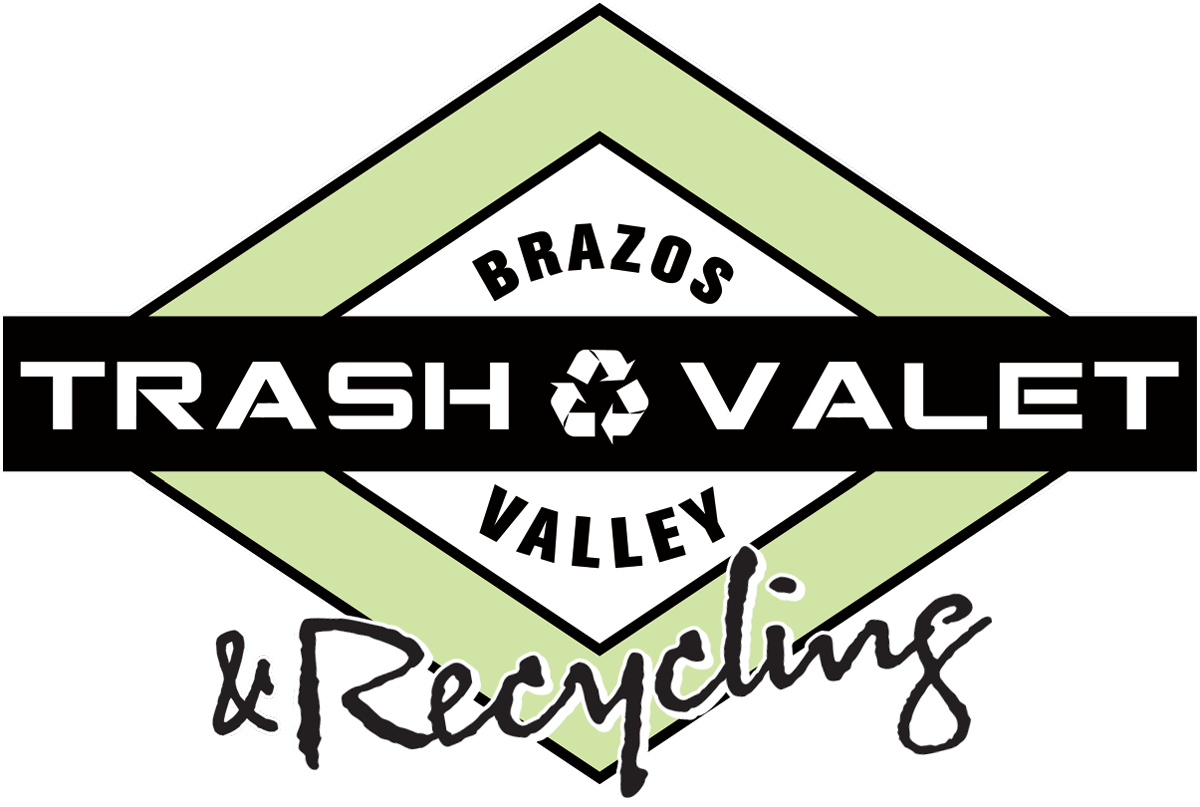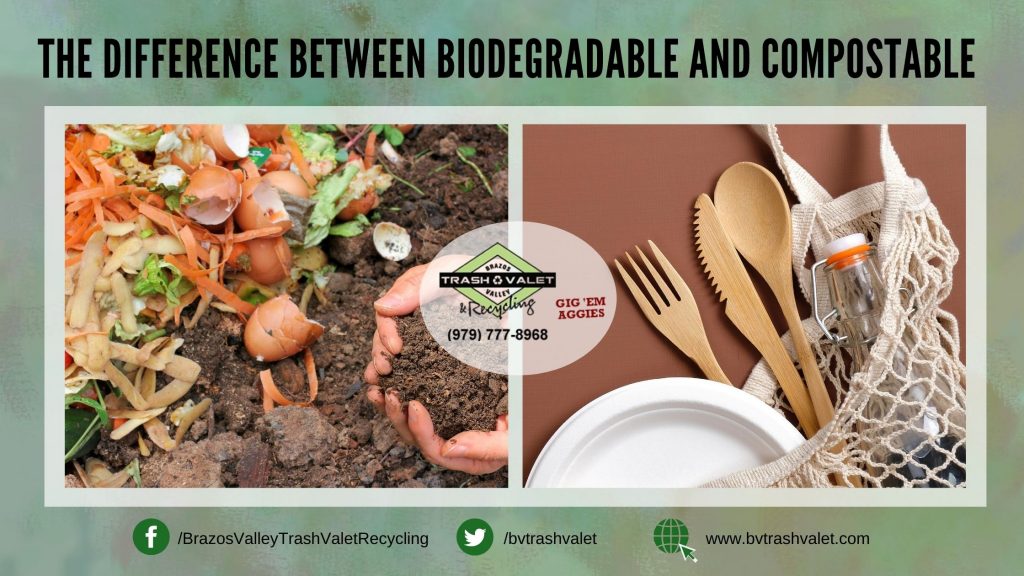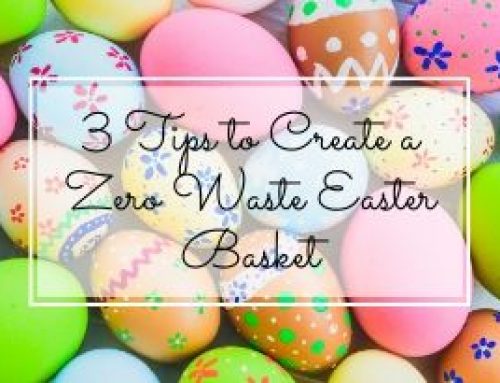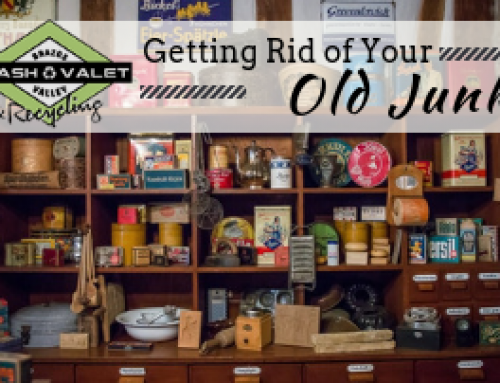The Difference Between Biodegradable and Compostable
Eco-conscious Brazos Valley residents often hear terms like “biodegradable” and “compostable.” It’s clear that these are important traits when it comes to living a greener lifestyle, but what do they mean? Are the two interchangeable, or are there differences in the way they should be handled? Should one be prioritized over the other? In today’s blog, we’ll break down the differences between biodegradable and compostable.
Biodegradable
“Biodegradable” describes any product or material that can be broken down by the biological process and eventually disintegrated. Essentially, biodegradable materials are returned to nature after a time. Of course, almost anything is biodegradable eventually, but some items take a longer period of time than others. Plastic materials, for instance, can take up to decades, which is why there’s so much plastic in landfills and ocean garbage patches. Thus it’s vital to prioritize biodegradable products over non-biodegradable products.
Some materials that are biodegradable include:
- Cork
- Bamboo
- Wood
- Paper or cardboard
- Linoleum
- Bioplastics like soybean
- Cotton
- Hide
Biodegradable materials are better for the environment overall, since they won’t clog landfills and garbage dumps. Some materials, such as wood, paper, and cardboard can also be recycled, cutting down on waste even more. In order for biodegradable materials to be degraded is for them to exist. Nature will do the rest. And this is the main way in which biodegradable is different from compostable.
Compostable
Compostable materials are organic materials that can serve as fertilizer when they decompose. In this way, it’s nature’s own attempt at recycling. We harvest and eat food, compost the scraps, and the decomposed food scraps help new plants to grow and be harvested.
In some cases, packaging is also compostable, as you may have seen on a label of something you recently bought. However, this version of composting works in a different way. Rather than being placed in your garden, compostable packaging material must be sent to an industrial composting facility to be made into compost professionally. These compostable packages will not necessarily decompose naturally in landfills.
In fact, that’s the primary difference between biodegradable and compostable. Compostable materials will naturally biodegrade and even help to enrich the earth, but they need specific conditions to do so. Many gardeners who use compostable food scraps use a tumbling compost bin or a compost sack. Earthworms also often help to speed along the process. Compostable packaging has to be composted in a facility. However, like biodegradable materials, composting is essential to a greener earth.
Compostable materials include:
- Food scraps
- Leaves and grass clippings
- Organic manure, as from horses
- Old wine
- Herbivore pet bedding
- Dry pet food
- Old herbs
- Non-glossy paper
- Cardboard
- Used clothes
- Natural fabrics
- Sawdust
- Wood chips
It’s good to know what constitutes biodegradable and compostable, and what you can do with those materials. For the rest, it’s good to have a single stream recycling company at your back, helping you live a greener life. Want to sign up for our trash and recycling pick-up? Contact Brazos Valley Trash Valet & Recycling today for more information.
Share This Story, Choose Your Platform!
The Difference Between Biodegradable and Compostable
Eco-conscious Brazos Valley residents often hear terms like “biodegradable” and “compostable.” It’s clear that these are important traits when it comes to living a greener lifestyle, but what do they mean? Are the two interchangeable, or are there differences in the way they should be handled? Should one be prioritized over the other? In today’s blog, we’ll break down the differences between biodegradable and compostable.
Biodegradable
“Biodegradable” describes any product or material that can be broken down by the biological process and eventually disintegrated. Essentially, biodegradable materials are returned to nature after a time. Of course, almost anything is biodegradable eventually, but some items take a longer period of time than others. Plastic materials, for instance, can take up to decades, which is why there’s so much plastic in landfills and ocean garbage patches. Thus it’s vital to prioritize biodegradable products over non-biodegradable products.
Some materials that are biodegradable include:
- Cork
- Bamboo
- Wood
- Paper or cardboard
- Linoleum
- Bioplastics like soybean
- Cotton
- Hide
Biodegradable materials are better for the environment overall, since they won’t clog landfills and garbage dumps. Some materials, such as wood, paper, and cardboard can also be recycled, cutting down on waste even more. In order for biodegradable materials to be degraded is for them to exist. Nature will do the rest. And this is the main way in which biodegradable is different from compostable.
Compostable
Compostable materials are organic materials that can serve as fertilizer when they decompose. In this way, it’s nature’s own attempt at recycling. We harvest and eat food, compost the scraps, and the decomposed food scraps help new plants to grow and be harvested.
In some cases, packaging is also compostable, as you may have seen on a label of something you recently bought. However, this version of composting works in a different way. Rather than being placed in your garden, compostable packaging material must be sent to an industrial composting facility to be made into compost professionally. These compostable packages will not necessarily decompose naturally in landfills.
In fact, that’s the primary difference between biodegradable and compostable. Compostable materials will naturally biodegrade and even help to enrich the earth, but they need specific conditions to do so. Many gardeners who use compostable food scraps use a tumbling compost bin or a compost sack. Earthworms also often help to speed along the process. Compostable packaging has to be composted in a facility. However, like biodegradable materials, composting is essential to a greener earth.
Compostable materials include:
- Food scraps
- Leaves and grass clippings
- Organic manure, as from horses
- Old wine
- Herbivore pet bedding
- Dry pet food
- Old herbs
- Non-glossy paper
- Cardboard
- Used clothes
- Natural fabrics
- Sawdust
- Wood chips
It’s good to know what constitutes biodegradable and compostable, and what you can do with those materials. For the rest, it’s good to have a single stream recycling company at your back, helping you live a greener life. Want to sign up for our trash and recycling pick-up? Contact Brazos Valley Trash Valet & Recycling today for more information.





